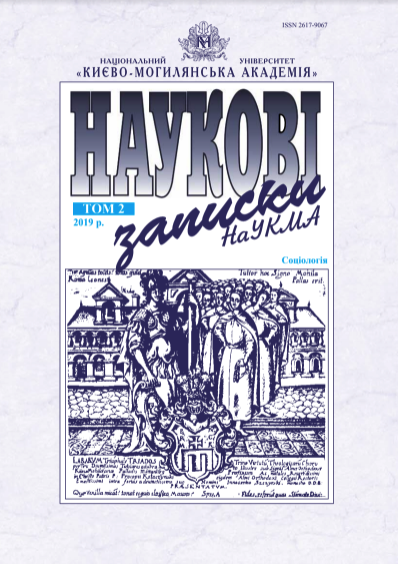Соціальний стрес та превалюючі стресори серед студентів бакалаврату НаУКМА
DOI:
https://doi.org/10.18523/2617-9067.2019.2.62-73Ключові слова:
соціальний стрес, хронічний стресор, вища освіта, рівень освіти бакалавр, УкраїнаАнотація
Соціальний стрес є складовою соціального життя і похідною від комплексних систематичних взаємин у групі. Стрес стає дедалі глобальнішою проблемою особливо серед студентів і негативно позначається саме на їхньому житті та здоров’ї. В основу цієї публікації покладено кількісне дослідження, проведене серед студентів (N = 100) усіх спеціальностей бакалаврату НаУКМА шляхом анкетування. Опитування комбінувало запитання відкритого і закритого форматів і збирало інформацію про найбільш стресові сфери життя (у формі самозвітів).Посилання
- Arakelov, G. G., Arshinova, V. V., & Zhdanova, G. E. (2008). Stress-faktory, vliyayuschie na formirovanie psihosotsialnoy ustoychivosti lichnosti v period studenchestva. Psihologicheskaya nauka i obrazovanie, 2, 52–60 [in Russian].
- Bowers, M. E., & Yehuda, R. (2016). Intergenerational transmission of stress in humans. Neuropsychopharmacology, 41 (1), 232–44.
- Brown, J. (2016). Mental health matters: A growing challenge. Boston University Today. Retrieved from bu.edu/today/2016/mental-health-college-students.
- Cockerham, W. (2013). Age, gender, and race/ethnicity as structural variables. Social causes of health and disease. Ch. 6 (pp. 138–163). Cambridge: Polity Press.
- Flinn, M. Why words can hurt us: Social relationships, stress and health. W. Trevathan, E. O. Smith, and J. McKenna (Eds.). Evolutionary Medicine and Health. Ch. 13 (pp. 247–258). Oxford: Oxford University Press.
- Garanyan, N. G., Holmogorova, A. B., & Evdokimova, Y. G. (2007). Predekzamenatsionnyiy stress і emotsionalnaya dezadaptatsiya u studentov mladshih kursov. Sotsialnaya і klinicheskaya psihiatriya, 17 (2), 38–42 [in Russian].
- Gasanova, R. R. (2015). Stressovyie situatsii studentov v protsesse obucheniya v vuze. Gumanitarnyie, sotsialno-ekonomicheskie i obschestvennyie nauki, 212–214 [in Russian].
- Grasso, D. J. (2012). Seeing the silver lining: potential benefits of trauma exposure in college students. Anxiety, Stress, and Coping, 25 (2), 117–136. DOI: https://doi.org/10.1080/10615806.2011.561922
- Greenberg, J. S. (2002). Upravlenie stressom [Stress Management]. Saint Petersburg, Russia: Piter [in Russian].
- Kyiv International Institute of Sociology (KIIS). (2016). Stressful Situations in the Lives of the Ukrainians, 2016. Retrieved from http://kiis.com.ua/?lang=eng&cat=reports&id=681&page=1.
- Lazarus, R. S., & Folkman, S. (1984). Stress, appraisal, and coping. New York, NY: Springer. Pp. 17–140.
- Makarenko, M. V., Lyzohub, V. S., & Yukhymenko, L. I. (2003). Sertsevyi rytm u studentiv z riznymy indyvidualno-typolohichnymy vlastyvostiamy vyshchoi nervovoi diialnosti za umov emotsiinoho stresu. Fiziolohichnyi zhurnal, 49 (1), 28–33 [in Ukrainian].
- Malenova, A. Y. (2012). Osobennosti otnosheniya i koping-povedeniya studentov zrelogo vozrasta v situatsii ekzamenatsionnoy attestatsii. Vestnik Omskogo universiteta, Psihologiya, 1, 59–67 [in Russian].
- Marmot, M. (2006). Status syndrome: A challenge to medicine. Commentary, 1304–1307.
- McLeod, J. (2012). The meanings of stress: Expanding the stress process model. Society and Mental Health, 2 (3), 172–186. DOI: https://doi.org/10.1177/2156869312452877
- McLeod, J. (2015). Why and how inequality matters. Journal of Health and Social Behavior, 56 (2), 149–165. DOI: https://doi.org/10.1177/0022146515581619
- Miller, S. M. (1987). Monitoring and blunting: Validation of a questionnaire to assess styles of information seeking under threat. Journal of Personality and Social Psychology, 52, 345–353. DOI: https://doi.org/10.1037//0022-3514.52.2.345
- Obrist, P. A. (1976). The cardiovascular – behavioral interaction: As it appears today. Psychophysiology, 13, 95–107. DOI: https://doi.org/10.1111/j.1469-8986.1976.tb00081.x
- Pearlin, L., Menaghan, E., Lieberman, M., & Mullan, J. (1981). The stress process. Journal of Health and Social Behavior, 22 (4), 337–356. DOI: https://doi.org/10.2307/2136676
- Pichurin, V. V. (2015). Kopinh-stratehii studentiv i psykholohichna hotovnist do profesiinoi pratsi. Pedahohika, psykholohiia ta medyko-biolohichni problemy fizychnoho vykhovannia i sportu, 2, 53–59 [in Ukrainian].
- Pressman, S. (2019). Positive affect and health: What do we know and where next should we go? Annual Reviews of Psychology, 70, 627–650. DOI: https://doi.org/10.1146/annurev-psych-010418-102955
- Rivers, J. J., & Josephs, R. A. (2010). Dominance and health: The role of social ranking physiology and illness. The social psychology of power. Ana Guinote and Theresa K. Vescio (Eds.), pp. 87–111. New York, NY: Guilford Press.
- Rosenberg, D. (2018). 1 in 5 college students have anxiety or depression. Here’s why. The Conversation. Retrieved from theconversation.com/1-in-5-college-students-have-anxiety-or-depression-heres-why-90440.
- Sapolsky, R. (2005). The influence of social hierarchy on primate health. Science, 308, 648–652. DOI: https://doi.org/10.1126/science.1106477
- Segerstrom, S. C., & Miller, G. E. (2004). Psychological Stress and the Human Immune System: A Meta-Analytic Study of 30 Years of Inquiry. Psychological Bulletin, 130 (4), 601–630. DOI: https://doi.org/10.1037/0033-2909.130.4.601
- Selin, H., & Davey, G. (Eds.) (2012). Happiness across cultures: Views of happiness and quality of life in non-Western cultures. NY: Springer. DOI: https://doi.org/10.1007/978-94-007-2700-7
- Tutushkin, L. N. (2014). Stress v romanticheskih otnosheniyah yunosheskogo vozrasta. Vestnik KGU im. N. A. Nekrasova, 20, 68–71 [in Russian].
- Varnum, M. E. W., & Hampton, R. S. (2018, July 27, preprint). Cultural changes in neural structure and function. DOI: https://doi.org/10.31234/osf.io/52eg3
##submission.downloads##
Як цитувати
Номер
Розділ
Ліцензія
Авторське право (c) 2019 Victoria Krupa, Kateryna Maltseva

Ця робота ліцензується відповідно до Creative Commons Attribution 4.0 International License.
Автори, які публікуються у цьому журналі, погоджуються з такими умовами:
а) Автори зберігають за собою авторські права на твір на умовах ліцензії Creative Commons Attribution License CC BY 4.0, котра дозволяє іншим особам вільно поширювати (копіювати і розповсюджувати матеріал у будь-якому вигляді чи форматі) та змінювати (міксувати, трансформувати, і брати матеріал за основу для будь-яких цілей, навіть комерційних) опублікований твір на умовах зазначення авторства.
б) Журнал дозволяє автору (авторам) зберігати авторські права без обмежень.
в) Автори мають право укладати самостійні додаткові угоди щодо поширення твору (наприклад, розміщувати роботу в електронному репозитарії), за умови збереження посилання на його першу публікацію. (Див. Політика Самоархівування)
г) Політика журналу дозволяє розміщення авторами в мережі Інтернет (наприклад, у репозитаріях) тексту статті, як до подання його до редакції, так і під час його редакційного опрацювання, оскільки це сприяє виникненню продуктивної наукової дискусії та позитивно позначається на оперативності та динаміці цитування опублікованої роботи (див. The Effect of Open Access).



